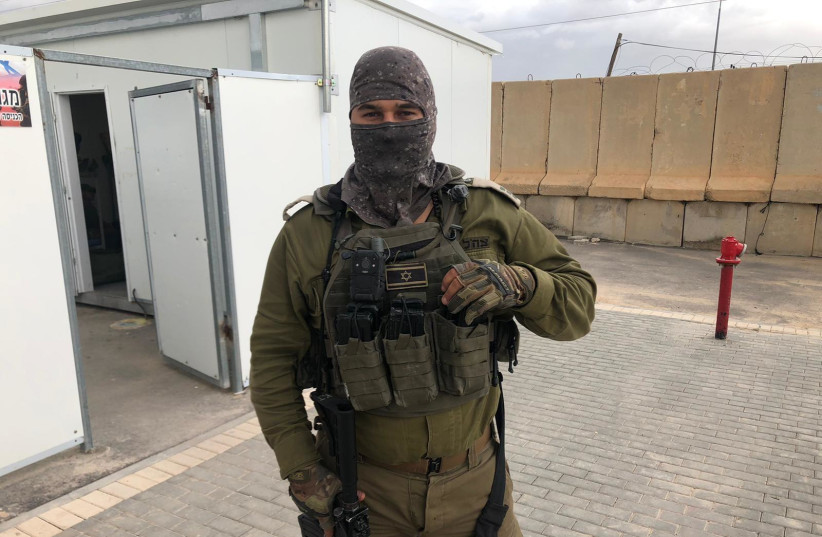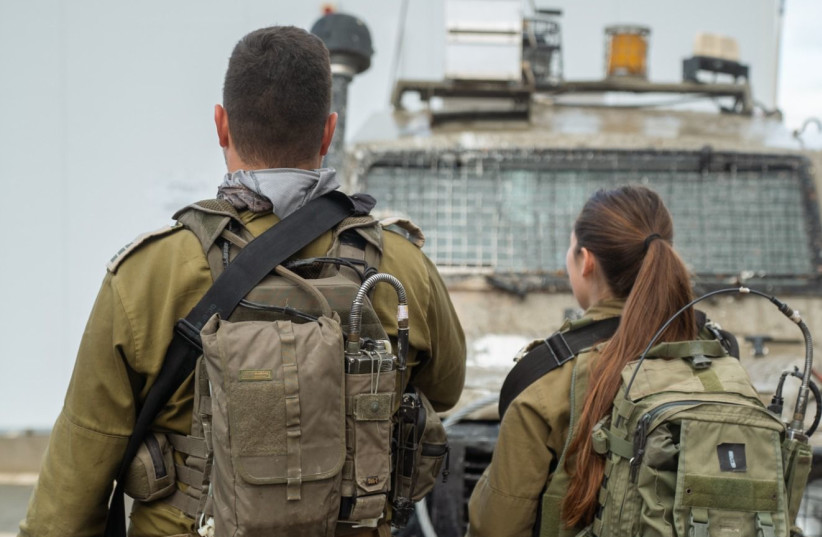IDF Lieutenant “K,” the commander of the 17 soldiers who killed five terrorists hiding out in Jericho in February, did not feel the two bullets that hit him (protected by a bulletproof vest) as he ordered his troops to pelt a suspicious storage area with gunfire.
In interviews this week with The Jerusalem Post, K, as well as female combat soldier “H” and male combat soldier “KE,” told of how they accidentally stumbled on the terror cell, took fire, survived the face-to-face gunfight from just centimeters away, and killed five members of the cell involved in an attempted shooting at the Almog Junction on January 28.
“All I did was do my job. In most pictures, the storage room did not exist. So it was new. I knew it was necessary to check it and then I saw seven terrorists,” said K, recounting the events in his own modest way, which lead to the operational success.
His unit’s job is to check areas for weapons and provide support to special forces units, like Maglan or Sayeret Matkal, who take on the more dangerous part of a bust.

Further, K said that the intelligence they had received indicated that the area they were probing would only hold concealed weapons and that a different area being probed by special forces was where the terror cell in question was expected to be hiding.
In other words, mistaken intelligence and stellar situational awareness of quickly realizing that the “new” storage room was out of place, was what led K and his unit to make Israeli history in terms of a mixed female and male unit taking out a terror cell.
IDF mixed gender unit makes history
K told the Post that, “they heard the cars coming” up to the storage room, so they were ready to fire at K as soon as he opened the storage door to look inside for what he thought would only be unguarded weaponry.
“When I opened the storage room, I saw bullets were fired but didn’t feel getting hit. I only thought about it afterward,” he said.
One bullet was stopped by K’s bulletproof vest. The other hit his gun’s ammunition chamber. Both were in the area of his upper body.
K said that these shots were fired at him from practically only centimeters away, almost point blank.
Having seen the gunfire, K “took a step backward from the storage room and called out for all of the soldiers to open fire.”
The 17 soldiers were split into two levels, with eight of them joining K in moving right up to the storage room and the others covering the back of that unit should any other hostile actors approach the area.
FOUR OF the eight soldiers were women, including K’s deputy commander, “A”; 10 of the 17 were women. Some of these other soldiers were standing in the open area and some were in armored vehicles, which themselves were blocking various angles from any outside attack.
When K and his troops opened fire on the terrorists, they riddled the storage room with gunfire, then fired on the roof in case anyone was in that position, then fired on some other side areas of the storage room in case anyone tried to escape and then fired again on the main area.
According to K, they were firing for about two minutes. During this time, some of the terrorists continued to return fire for – at least the first 10 seconds.
However, K explained that one of the reasons they were not hit was that he and his soldiers were firing from mostly protected armored positions, with just enough space to fire on the storage room.
K said that among the four female and four male soldiers, “there was no hesitation, there were no questions. They all responded just like we learned and trained.”
When K and his soldiers entered the storage room, they saw two terrorists wounded but reaching for their weapons, so they fired again to neutralize them completely. The two survived.
Asked about how he felt about the incident, he said that despite the massive media attention he and his unit received (he is conducting over half-a-dozen interviews), “there was no feeling of wow, that was fun, that was sensational. We just carried out our mission and did our jobs.”
Regarding his unit’s readiness for an all-out firefight, he said that training tries “to connect what they learn to what will happen in the field, it is not just random training. We make sure the training leads to encountering the real-time stress of real field operations in order to respond properly. If you are taught properly, it helps you imagine what could happen and how you could feel.
“This is the job. There is no time to get stuck on emotions,” K said, though he admitted that once the entire operation was over, “there was a bit of an emotional release.”
He said that it was not until they started to receive media attention and responses from friends and family that they realized how high-profile the operation was.
'For every operation, we need to be ready for any situation'
K HAD been in two prior incidents where he exchanged fire with Palestinians, but besides those, he had been in possibly hundreds of arrest operations.
He said that his soldiers were also more ready for this firefight because of the many previous arrest operations and that, “for every operation, we need to be ready for any situation.”
Next, K was asked about how the special forces soldiers reacted to the fact that K’s unit handled the hard and dangerous part of the operation, with the special forces helping with the cleanup – an inversion of how things usually go.
“They were extremely disappointed. We were supposed to only be checking for unguarded weaponry,” and the special forces had expected they would get to take down the terror cell.
Moreover, he said, “I hope we will get more opportunities for big operations.”
Asked about the special dynamics which go along with a combat unit of mixed female and male soldiers, K said, “there are clear laws for everything. There are set accepted clothing standards – even when they are playing sports or exercising – which are very exact. This is a job and it is carried out professionally.”
When asked about whether there were different levels of quality between the male and the female soldiers, especially in physical fighting, he responded, “They are at the same level,” adding that ‘Krav Maga’ [Israeli combat techniques] is based on the idea of “operating from a defensive perspective.”
“You need to be ready for how to deal with being outnumbered, to be smaller physically than an attacker, to be able to find a chair or other object to use in defense, or for how to disarm an attacker who is holding a knife,” he said.
If Jenin and Nablus are currently thought of us as places where the Palestinian Authority has less control, leading the IDF to regularly intervene there, Jericho is thought of as more of a PA stronghold where the IDF rarely acts.
“They still have more control and a better economic situation in general, but if the picture changes in the coming months, if there are new dangerous elements, then we will stop them. We will be ready for any terror cell. We are very proud of the male and female fighters,” said K.

COMBAT SOLDIERS H (female) and KE (male) played supporting roles in the operation.
H helped cover the inner force of 8 soldiers from outside Palestinian interference. She said that at some point, other Palestinians started to converge on her position, some throwing rocks.
She called for backup, and when the Palestinians saw additional IDF forces coming to help, they retreated.
“I hadn’t seen gunfire. This was the first time. It was scary. Everyone thought we were all only checking for weapons,” said H.
She added that during previous “confrontations [without gunfire] I know what I should be doing. But the gunfire caused me fear because it could hit you. It’s stressful,” though she also said that she knew how to do her job.
Similarly, KE said he had encountered rock throwing and Molotov cocktails, but not gunfire and was also fearful.
Still, “it means you are more ready the next time. Mostly you are ready automatically to do the job because of prior training. You know when to wait to act and when and how to shoot. You receive orders over the communications channels, so you know what to do,” said KE.
Asked when she realized that the episode had attracted huge public national attention, H said, “I didn’t know at first and didn’t think it would. Only when I read about it in the media and started to see a line of reporters coming to visit.”
She added that her, “mom did not sleep the whole night of the operation.”
Both H and KE said that the fact that the whole mixed unit came into basic training together and continued their entire IDF service together, now up to 18 months, has helped the group dynamic.
H temporarily left the group to do a special course on a track to advance to a higher rank but was still excited to return to the group after the course.
H and KE said that the mixed unit did essentially everything together in similar ways and that female soldiers have met the same standards as their male counterparts in various areas of rating combat soldiers, other than that women are permitted to do certain activities with lower weight thresholds.
Asked why she wanted to be a combat soldier with men when none of her friends chose that path, H said, “I just wanted to do it. I wanted a different experience in serving the country. I wanted to contribute more and do whatever I could.”
In contrast, KE said he originally wanted to serve in a more elite unit composed only of men, but once he was placed in the mixed unit, he was very impressed by his female counterparts. “Once I got here, I saw everything is the same” between the female and male soldiers.
